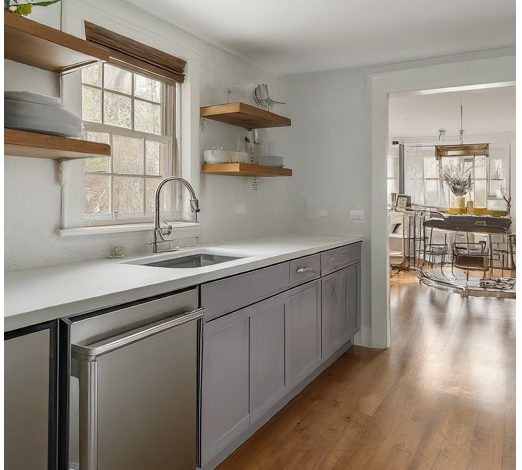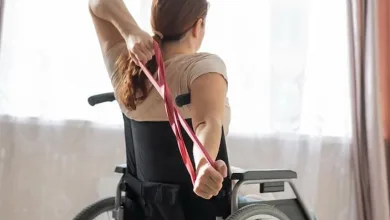Kitchen Efficiency for Wheelchair Users

Table of Contents
Kitchen Efficiency for Wheelchair Users
Cooking Up Independence: A Guide to Kitchen Efficiency for Wheelchair Users
Imagine whipping up a delicious meal in your kitchen, but obstacles stand in your way. This scenario is a reality for many wheelchair users whose kitchens aren’t designed for accessibility. But fear not! Creating a kitchen that fosters independence and allows you to unleash your inner chef is entirely possible.
This comprehensive guide delves into the world of kitchen efficiency for wheelchair users. We’ll explore essential elements like layouts, cabinets, dimensions, and disability regulations to transform your kitchen into a functional and enjoyable space.
Small Kitchen Efficiency for Wheelchair Users

Living in a compact space doesn’t have to limit your culinary adventures. Here are clever strategies to maximize efficiency in a small kitchen for wheelchair users:
- Master the Work Triangle: The work triangle refers to the imaginary path you take between the sink, stove, and refrigerator. In a small kitchen, ensure these appliances are close together, minimizing unnecessary movement.
- Prioritize Lowered Countertops: Standard countertops can be a barrier. Consider lowering them to around 34 inches for easy access while prepping food or washing dishes.
- Embrace Pull-Out Shelves and Drawers: These ingenious storage solutions bring hidden treasures within reach, eliminating the need to stretch for items in upper cabinets.
- Utilize Wall Space Wisely: Install shelves with lightweight items like spices or cookbooks at a comfortable height for easy access.
Wheelchair Accessible Kitchen Layout

A well-planned layout is the foundation of a wheelchair accessible kitchen. Here’s what to consider:
- The Golden Rule: The Work Triangle: As mentioned before, a compact work triangle ensures a smooth workflow. For optimal efficiency in larger kitchens, consider a U-shaped or L-shaped layout.
- Clear Work Zones: Divide your kitchen into designated zones for specific tasks, like a food prep area, cooking zone, and cleaning station. This minimizes unnecessary maneuvering.
- Turning Radius: When planning your layout, factor in the turning radius of your wheelchair. Ideally, there should be a 60-inch clearance space to allow for smooth turning.
- Accessibility Beyond the Kitchen: Consider the accessibility of pathways leading into the kitchen from other rooms. Ensure doorways are wide enough for wheelchairs to pass comfortably.
Accessible kitchen design goes beyond just layout. Here are additional elements to incorporate:

- Lowered Countertops: This is a crucial element for wheelchair users. Aim for a countertop height of 34 inches or less for easy access and comfortable maneuvering.
- Clear Knee Space: Ensure there’s sufficient space under the counter for your knees to fit comfortably while seated at the counter.
- Accessible Appliances: Look for appliances that cater to specific needs. Opt for ovens placed lower in the wall or counter-mounted for easier access. Similarly, single-lever faucets on sinks are more accessible to operate with one hand.
Wheelchair Accessible Kitchen Cabinets

Cabinets play a vital role in kitchen organization. Here’s how to make them wheelchair accessible:
- Lower Cabinets: Frequently used items should be stored in lower cabinets within easy reach. This eliminates the need to stretch or reach for items in upper cabinets.
- Pull-Out Shelves and Drawers: These are game-changers in accessible kitchens. They bring the contents of cabinets closer, providing a clear view and easy access to everything inside.
- Lazy Susan Turntables: Utilize these in corner cabinets to maximize storage space and make hidden items easily accessible.
Wheelchair Accessible Kitchen Dimensions

Understanding wheelchair accessible kitchen dimensions is crucial for optimal functionality:
- Clearance Under Countertop: Allow at least 27 inches of knee space under the countertop for comfortable maneuvering while seated.
- Clear Floor Space: Maintain a minimum of 60 inches of clearance in front of countertops and appliances to allow wheelchairs to turn smoothly.
- Doorway Width: Ensure doorways leading into the kitchen are at least 32 inches wide to accommodate wheelchairs comfortably.
Disabled Kitchen Regulations
While there isn’t a universally mandated set of disabled kitchen regulations, several guidelines exist to promote accessibility. Here are some essential resources:
- The Americans with Disabilities Act (ADA): The ADA outlines accessibility standards for public and commercial spaces. While not directly applicable to private residences, these guidelines offer valuable insights for creating accessible kitchens. You can find the ADA Standards for Accessible Design at https://www.justice.gov/opa/pr/justice-department-s-2010-ada-standards-accessible-design-go-effect.
- National Kitchen and Bath Association (NKBA): The NKBA publishes accessibility guidelines for kitchens and bathrooms, which can be a helpful reference point for homeowners. These guidelines are available for purchase on the NKBA website: https://nkba.org/
Pros and Cons of Different Accessible Kitchen Layouts
When choosing a wheelchair accessible kitchen layout, consider the pros and cons of each option:
U-Shaped Kitchen
- Pros:
- Maximizes Counter Space: U-shaped layouts offer the most counter space of the three options, providing ample room for food prep, cooking, and cleaning.
- Efficient Work Triangle: The U-shape naturally creates a compact and efficient work triangle, minimizing unnecessary movement between the sink, stove, and refrigerator.
- Multiple Work Zones: This layout allows for the creation of designated work zones, like a chopping station near the sink or a baking zone closer to the oven.
- Cons:
- Limited Suitability for Small Kitchens: U-shaped layouts can feel cramped in smaller kitchens. Ensure there’s ample turning radius space for your wheelchair.
- Accessibility in the Middle: Depending on the design, reaching items in the centre section of the U could be challenging. Consider open shelving or pull-out drawers for improved accessibility.
L-Shaped Kitchen
- Pros:
- Good Work Triangle Flow: L-shaped kitchens often provide a good flow for the work triangle, making them efficient for navigating between key appliances.
- Adaptable to Larger Kitchens: This layout can be configured in various ways to suit larger kitchens, offering flexibility in design.
- Open Space Potential: An L-shaped layout can leave one wall open, creating a more spacious feel and potentially allowing for additional seating or storage.
- Cons:
- Counter Space Limitations: Depending on the design, counter space might be limited compared to a U-shaped layout. Careful planning is crucial to ensure enough prep and work surfaces.
- Corner Accessibility: Reaching items in the corner cabinets of an L-shaped kitchen might require additional solutions, such as lazy Susan turntables or pull-out shelves.
Galley Kitchen
- Pros:
- Ideal for Narrow Kitchens: Galley kitchens, with countertops on opposite walls, maximize space in narrow kitchens.
- Clear Work Path: The parallel counter configuration creates a clear work path, minimizing unnecessary maneuvering.
- Cons:
- Increased Maneuvering: Turning a wheelchair in a galley kitchen might require more back-and-forth movement due to the limited space.
- Limited Counter Space: This layout typically offers less counter space compared to U-shaped or L-shaped layouts.
- Traffic Flow Considerations: Galley kitchens can feel congested if multiple people are using the kitchen simultaneously.
Additional Considerations
- Doorways: Ensure doorways leading into the kitchen are wide enough (at least 32 inches) to comfortably accommodate wheelchairs.
- Turning Radius: When designing the layout, factor in your wheelchair’s turning radius. Aim for a minimum of 60 inches of clearance around countertops and appliances for smooth maneuvering.
- Open Floor Plan: Consider an open floor plan that connects the kitchen to other living areas, promoting social interaction and improved accessibility.
A chart summarizing the pros and cons of different accessible kitchen layouts for wheelchair users:
| Layout | Pros | Cons |
| U-Shaped Kitchen | * Maximizes counter space * Efficient work triangle * Multiple work zones | * Limited suitability for small kitchens * Accessibility in the middle |
| L-Shaped Kitchen | * Good work triangle flow * Adaptable to larger kitchens * Open space potential | * Counter space limitations * Corner accessibility |
| Galley Kitchen | * Ideal for narrow kitchens * Clear work path | * Increased maneuvering * Limited counter space * Traffic flow considerations |
By carefully considering these factors and the pros and cons of each layout, you can choose the best option to create a functional and user-friendly kitchen that empowers your culinary adventures!
Maximizing Efficiency in Your Accessible Kitchen
Now that you’ve explored essential design elements let’s delve into strategies to maximize efficiency in your accessible kitchen.
Organization is Key
- Categorize and Store: Group similar items together and store frequently used items within easy reach. This minimizes time spent searching for utensils or ingredients.
- Label Everything: Clearly label shelves, drawers, and cabinets for a quick visual reference. This is especially helpful for those with visual impairments.
- Utilize Dividers and Organizers: Invest in drawer dividers and cabinet organizers to keep items neatly categorized and prevent clutter.
Adaptive Equipment
Assistive tools can be a game-changer in the kitchen. Here are some examples:
- Long-Handled Reachers: These extend your reach to grab items from high shelves or cabinets.
- Jar Openers: Specialized jar openers eliminate the struggle of opening tight lids.
- Cutting Boards with Spikes: These prevent food from slipping while chopping, promoting safety and ease of use.
- Countertop Can Openers: These hands-free can openers make opening cans effortless.
Smart Technology
While not essential, smart technology can add an extra layer of convenience to your accessible kitchen:
- Voice-Activated Appliances: You can control appliances like ovens or microwaves with voice commands, eliminating the need to bend or reach for controls.
- Smart Lighting: Voice-activated or motion-sensor lighting frees your hands and allows for better task illumination while cooking.
Adding Personal Touches
Don’t forget to infuse your kitchen with personality! Here are some ideas:
- Decorative Accents: Spruce up your space with colourful accents, artwork, or plants that reflect your style.
- Accessible Seating: Choose a comfortable chair with good back support and armrests for added stability while working at the counter.
- Lowered Hanging Plants: Display greenery at a comfortable viewing height to add a touch of nature to your kitchen.
FAQs for Kitchen Efficiency for Wheelchair Users:
I have limited hand strength. Are there countertop appliances that can make food prep easier?
Absolutely! Consider investing in a food processor, chopper, or blender to assist with tasks like chopping vegetables, grinding spices, or pureeing ingredients. These appliances can significantly reduce the need for hand strength while prepping food.
Can I modify my existing cabinets to make them more accessible?
Yes, there are several ways to modify existing cabinets. You can install pull-out shelves and drawers to bring contents closer, replace solid cabinet doors with glass for easier visibility, or add lower shelves for frequently used items.
What flooring is best for a wheelchair-accessible kitchen?
Opt for smooth, slip-resistant flooring like vinyl or laminate. Avoid thick carpets or rugs that could hinder wheelchair movement. Consider textured tiles for added grip, but ensure they’re still easy to roll over.
How can I make my sink more accessible?
Look for faucets with single-lever handles for easy operation with one hand. Install a pull-out sprayer for greater reach and flexibility. Consider a sink with a lowered countertop for easier access from a seated position.
I live in an apartment. Are there portable solutions to improve kitchen accessibility?
Yes! Portable counter extensions can be placed on existing countertops to create a lower work surface. Grab bars specifically designed to clamp onto countertops for added stability are also available.
What kind of lighting is ideal for an accessible kitchen?
Task lighting is crucial. Under-cabinet lighting illuminates work surfaces, while pendant lights over the sink or prep areas provide targeted light. Consider dimmer switches to adjust brightness for specific tasks.
Are there countertop modifications that can improve accessibility?
Absolutely! Cutting boards with built-in grips prevent food from slipping while chopping. Consider installing a recessed cooktop with smooth edges for easier maneuvering around the cooking surface.
How can I organize my pantry for better accessibility?
Utilize clear containers with labels for easy identification of ingredients. Store frequently used items on lower shelves and heavier items on stable, lower-level pull-out drawers.
What resources can help me with the financial aspects of creating an accessible kitchen?
Government grants or financial assistance programs might be available depending on your location. Research local resources or contact disability advocacy groups for information.
How can I involve family members in creating an accessible kitchen?
Involving family members fosters a sense of ownership and inclusivity. Encourage their participation in planning discussions, suggesting ideas for organization or choosing decorative elements that reflect everyone’s taste.
Conclusion
With careful planning and a touch of creativity, you can transform your kitchen into a space that empowers your culinary adventures. Remember, an accessible kitchen doesn’t have to be sterile or institutional. It can be a beautiful, functional, and personalized haven for creating delicious meals and joyful memories.
So, roll up your sleeves and unleash your inner chef! The kitchen awaits your culinary creations.
Help Us Create the Ultimate Kitchen for Everyone: Share Your Thoughts!
We’re passionate about creating accessible kitchens that empower everyone to unleash their inner chef! But we can’t do it alone. Your voice matters!
Whether you’re a wheelchair user with valuable experience or simply someone who wants to contribute to a more inclusive kitchen environment, we invite you to share your thoughts in the comments section below. Here are some prompts to get you started:
- Wheelchair Users: What are some essential features or modifications that make a kitchen truly accessible and efficient for you?
- General Users: Have you ever considered the challenges faced by wheelchair users in the kitchen? What design elements or considerations would promote greater inclusivity in kitchens?
- Anyone: Do you have any questions or suggestions related to kitchen efficiency or accessibility?
Together, we can create kitchens that are not only beautiful and functional but also open to everyone!
Feel free to share your experiences, ideas, or questions in the comments below. We look forward to a lively and informative discussion!



